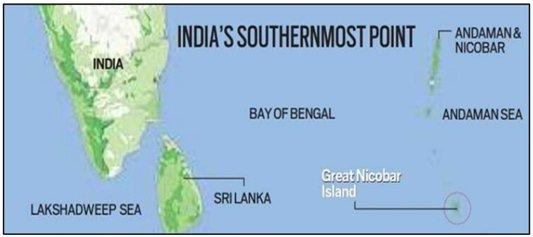Why in news? The main opposition party has called the proposed Rs 72,000-crore infrastructure upgrade at Great Nicobar Island a grave threat to the island's indigenous people and fragile ecosystem.
They demanded an immediate halt to all project clearances and a thorough, impartial review by relevant Parliamentary committees.
What’s in today’s article?
- Great Nicobar Island – location, ecosystem, tribes
- Great Nicobar Island project
Great Nicobar Island
- Geographical location

- Great Nicobar, the southernmost of the Andaman and Nicobar Islands.
- The Andaman and Nicobar Islands are a cluster of about 836 islands in the eastern Bay of Bengal.
- The two groups of which are separated by the 150-km wide Ten Degree Channel.
- The Andaman Islands lie to the north of the channel, and the Nicobar Islands to the south.
- Indira Point on the southern tip of Great Nicobar Island is India’s southernmost point, less than 150 km from the northernmost island of the Indonesian archipelago.
- Ecosystem
- The Great Nicobar Island has tropical wet evergreen forests, mountain ranges reaching almost 650 m above sea level, and coastal plains.
- The Island has two national parks and a biosphere reserve.
- Many endangered species are found at the Island. The leatherback sea turtle is the island’s flagship species.
- Tribes of Nicobar
- Great Nicobar is home to the Shompen and Nicobarese tribal peoples.
- The Shompen are hunter-gatherers who depend on forest and marine resources for sustenance.
- The Nicobarese, who lived along the west coast of the island were mostly relocated after the 2004 tsunami.
- An estimated 237 Shompen and 1,094 Nicobarese individuals now live in a 751 sq km tribal reserve, some 84 sq km of which is proposed to be denotified.
Great Nicobar Island project
- Background
- In November 2022, the Environment ministry has given environmental clearance for the Centre’s ambitious Rs 72,000 crore multi-development projects in Greater Nicobar Island.
- The project for the holistic development of Great Nicobar Island was implemented after a report by NITI Aayog.
- A pre-feasibility report flagged the opportunity to leverage the strategic location of the island.
- Proposal
- The Great Nicobar Island (GNI) is a mega project to be implemented at the southern end of the Andaman and Nicobar islands.
- The project includes an international container trans-shipment terminal, a greenfield international airport, township development, and a 450 MVA gas and solar based power plant over an extent of 16,610 hectares in the island.
- The port will be controlled by the Indian Navy, while the airport will have dual military-civilian functions and will cater to tourism as well.
Why government is keen to develop this Island?
- Economic reasons
- The government’s greater goal is to leverage the locational advantage of the island for economic and strategic reasons.
- Great Nicobar is equidistant from Colombo to the southwest and Port Klang and Singapore to the southeast.
- It is positioned close to the East-West international shipping corridor, through which a very large part of the world’s shipping trade passes.
- The proposed ICTT can potentially become a hub for cargo ships travelling on this route.
- As per the NITI Aayog report, the proposed port will allow Great Nicobar to participate in the regional and global maritime economy by becoming a major player in cargo transshipment.
- Strategic & Security reasons
- The proposal to develop Great Nicobar was first floated in the 1970s, and its importance for national security and consolidation of the Indian Ocean Region has been repeatedly underlined.
- Increasing Chinese assertion in the Bay of Bengal and the Indo-Pacific has added great urgency to this imperative in recent years.
- India is wary of a build-up of Chinese maritime forces at the Indo-Pacific choke points of especially Malacca, Sunda, and Lombok.
- China’s attempts to expand its footprint in the region includes building a military facility at Coco Islands (Myanmar) lying just 55 km to the north of the Andaman & Nicobar Islands.
- Close surveillance of the entire area around the archipelago, and the building up of a strong military deterrence at Great Nicobar is of vital importance to India’s national security.
Concerns
- Threat to Island Ecology
- The proposed massive infrastructure development in an ecologically important and fragile region has alarmed many environmentalists.
- The loss of tree cover will not only affect the flora and fauna on the island, it will also lead to increased runoff and sediment deposits in the ocean, impacting the coral reefs in the area.
- Environmentalists have also flagged the loss of mangroves on the island as a result of the development project.
- The port project could destroy coral reefs, disrupt the local marine ecosystem, and threaten the Nicobar Megapode bird and leatherback turtles in the Galathea Bay area.
- Impact on Indigenous People
- Critics point out that there will be devastating impact on the Shompen, a particularly vulnerable tribal group (PVTG) of hunter-gatherers with an estimated population of a few hundred individuals living in a tribal reserve on the island.
- They allege that the project violates tribal rights.
- The local administration is accused of not adequately consulting the Tribal Council of Great and Little Nicobar Islands.
- In November 2022, the council revoked a no-objection certificate for diverting about 160 sq km of forest land, citing incomplete information.
- Seismic Concerns
- Many experts have highlighted that the proposed port is in a seismically volatile zone, which experienced a permanent subsidence of about 15 ft during the 2004 tsunami.
- National Green Tribunal's intervention
- In April 2023, the Kolkata Bench of the National Green Tribunal (NGT) declined to interfere with the environmental and forest clearances granted to the project.
- However, it ordered the formation of a high-power committee to review the clearances. The status of the committee's report is still unclear.










